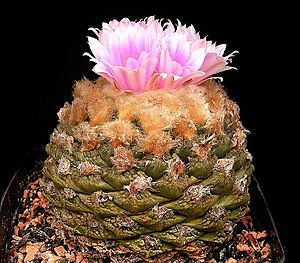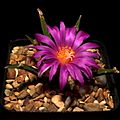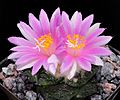Ariocarpus facts for kids
Quick facts for kids Ariocarpus |
|
|---|---|
 |
|
| Ariocarpus fissuratus | |
| Scientific classification |
|
| Kingdom: | Plantae |
| Clade: | Tracheophytes |
| Clade: | Angiosperms |
| Clade: | Eudicots |
| Order: | Caryophyllales |
| Family: | Cactaceae |
| Subfamily: | Cactoideae |
| Tribe: | Cacteae |
| Genus: | Ariocarpus Scheidw. |
| Species | |
|
See text. |
|
| Synonyms | |
|
|
Ariocarpus is a small group of succulent plants that belong to the Cactaceae family. These plants are known for their unique shapes and beautiful flowers.
The name Ariocarpus comes from ancient Greek words. "Aria" means a type of oak tree, and "carpos" means fruit. This name was chosen because the fruits of Ariocarpus plants look a bit like acorns. Another idea is that the person who named them, Scheidweiler, might have thought they looked like the fruits of a tree called Sorbus aria.
These special cacti grow in dry, sunny places. You can find them on limestone hills in southern Texas and in northern and central Mexico. Sadly, Ariocarpus plants are quite rare and are considered endangered in the wild. This means they are at risk of disappearing if we don't protect them.
Contents
What Are Ariocarpus Like?
Ariocarpus plants grow very slowly. They have thick, turnip-like roots that go deep into the ground. Most plants grow alone, but some can form small groups of stems.
Stems and Spines
Unlike many cacti, Ariocarpus stems have triangular bumps called tubercules. In some types, these bumps can even look like leaves! The small spots where spines usually grow, called areoles, can look different on each plant. They might be grooves on the top or round pads near the tips.
Young Ariocarpus plants (seedlings) usually have spines. But as they get older, most species lose their spines. One exception is Ariocarpus agavoides, which sometimes keeps its spines.
Flowers and Seeds
The flowers of Ariocarpus are shaped like funnels and grow from a fuzzy spot at the top of the plant. They come in many colors, like white, yellow, pink, purple, or magenta. After the flowers, the plants produce black, pear-shaped seeds.
These plants contain natural chemicals that taste bitter and are a bit toxic. These chemicals help protect the plant from being eaten by animals.
How Ariocarpus Got Its Name
The story of how Ariocarpus got its name is a bit complicated. In 1838, a scientist named Michael Scheidweiler first described the plant and gave it the name Ariocarpus retusus. He used plants sent from Mexico.
Another scientist, Charles Lemaire, also received the same plants. He described them in 1839 and gave them a different name, Anhalonium prismaticum. Even though Scheidweiler's name came first, Lemaire was a well-known cactus expert, so many people used his name for a long time. However, Scheidweiler's name was the correct one because it was published first.
Over time, scientists have moved some Ariocarpus species into different groups and then back again. For example, Ariocarpus agavoides was once in its own group called Neogomesia, but now it's part of Ariocarpus.
Types of Ariocarpus
As of 2018, scientists recognize these main types of Ariocarpus plants:
| Image | Scientific Name | Where It Grows |
|---|---|---|
 |
Ariocarpus agavoides | Mexico. |
 |
Ariocarpus bravoanus | San Luis Potosí in Mexico. |
 |
Ariocarpus fissuratus | Northern Mexico and Texas in the United States. |
 |
Ariocarpus kotschoubeyanus | Northeastern Mexico (Coahuila, Nuevo León, and Querétaro states). |
 |
Ariocarpus retusus | Mexico. |
 |
Ariocarpus scaphirostris | Nuevo León state in northeastern Mexico. |
 |
Ariocarpus trigonus | Mexico (Tamaulipas and Nuevo León states). |
Natural Mixes
Sometimes, different types of Ariocarpus can naturally cross-breed in the wild. One example is:
- Ariocarpus × drabi (a mix of A. kotschoubeyanus and A. retusus)
Where Ariocarpus Live
Most Ariocarpus plants are found in the central, northeastern, and southwestern parts of Mexico. They don't grow in western Mexico, like Baja California, or in the southeast, like Yucatán. However, Ariocarpus fissuratus also grows in southern Texas in the United States, especially in the Chihuahuan Desert.
Ariocarpus plants are very good at living in dry, tough places. A large part of the plant is its big underground root system. The stem often grows very close to the ground, or even below it, and has a thick outer skin to protect it from the sun and dryness.
Growing Ariocarpus
Even though Ariocarpus plants grow slowly, some types, like A. retusus, are not too hard to grow if you know how.
These plants have deep roots and are sensitive to the soil they grow in. They prefer soil that drains water very well and has very little plant material (humus). It's important not to give them too much water. Let the soil dry out completely between waterings. They only need water during the summer when they are growing. In winter, they should be kept completely dry. They need a minimum temperature of about 12°C (54°F), though some types can handle cooler weather.
You can grow Ariocarpus from seeds. It takes a long time, but it's not too difficult.
Sometimes, people graft young Ariocarpus plants onto other faster-growing cacti, like Pereskiopsis. This helps them grow much faster. Older plants can be grafted onto other cacti like Echinopsis or Eriocereus to make them tougher. However, grafted plants might look different from those grown naturally.
See also
 In Spanish: Ariocarpus para niños
In Spanish: Ariocarpus para niños

